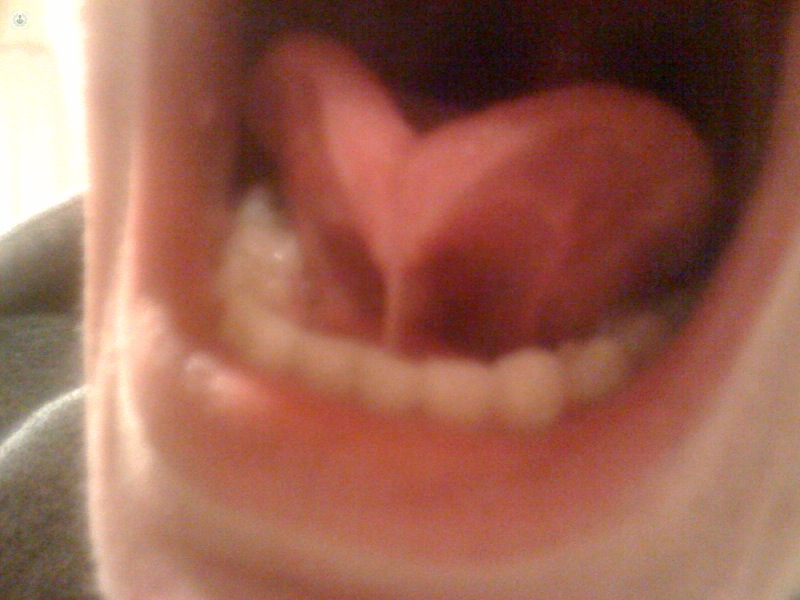What is tongue-tie?
Tongue-tie, or ankyloglossia, is a congenital condition in which the lingual frenulum (the band of tissue that anchors the bottom of the tongue to the floor of the mouth) is abnormally short and thick, which prevents the tongue from moving freely.
While some babies seem unbothered by it, in others it can cause them to struggle when breastfeeding, which is often when the condition is noticed.
Tongue-tie is thought to affect 4-11% of newborn babies and is more common in boys than girls.

Symptoms of tongue-tie
The key symptom is the short, thick membrane holding the tongue to the bottom of the mouth, which can make the tongue form a heart shape when they stick it out. This, in turn, can cause several signs that might alert the baby’s parents or doctors to the problem:
- Difficulty moving or sticking out the tongue
- Difficulty latching on to the nipple or staying attached when breastfeeding
- Being underweight or not gaining weight as quickly as expected
- Being hungry all the time
- A clicking sound when the baby feeds
If the baby has tongue-tie, this can also affect the mother’s breasts. For example, she may suffer from sore or cracked nipples or mastitis (inflammation of the breast), and her milk supply may be lower than it should be.
In older children and adults, tongue-tie can impede speech and could cause difficulty eating certain food.
What are the causes of tongue-tie?
It is unknown why the lingual frenulum doesn’t separate before birth in cases of tongue-tie, but it is thought genetic factors may be involved, as it seems to run in families.
Treatments for tongue-tie
The standard treatment is tongue-tie division – a surgical procedure that involves cutting the lingual frenulum. Tongue-tie division is quick, simple, and causes little to no pain or discomfort. In very young babies, there are very few nerve endings where the lingual frenulum is located, and some have been known to sleep through the procedure without anaesthetic, though others will cry. In older babies with teeth, general anaesthetic is needed to render them unconscious.
The procedure is carried out by specially trained doctors, nurses or midwives. Some practitioners use sterile scissors, while others use laser technology to snip the membrane.
Babies who have had tongue-tie division seem to breastfeed much more easily after the procedure.
Tongue-tie may not be treated at all if the baby doesn’t seem bothered by it and is able to feed. Tightness in the lingual frenulum may resolve on its own, given time. However, if it is still causing problems such as a speech impediment in older children and adults, tongue-tie division can still be carried out, but may require stitches.
Which type of specialist treats tongue-tie?
Paediatric surgeons or maxillofacial surgeons are usually called upon to perform tongue-tie division.
07-15-2013 12-21-2023Tongue tie
Mr Stefano Giuliani - Paediatric surgery
Created on: 07-15-2013
Updated on: 12-21-2023
Edited by: Conor Dunworth
What is tongue-tie?
Tongue-tie, or ankyloglossia, is a congenital condition in which the lingual frenulum (the band of tissue that anchors the bottom of the tongue to the floor of the mouth) is abnormally short and thick, which prevents the tongue from moving freely.
While some babies seem unbothered by it, in others it can cause them to struggle when breastfeeding, which is often when the condition is noticed.
Tongue-tie is thought to affect 4-11% of newborn babies and is more common in boys than girls.

Symptoms of tongue-tie
The key symptom is the short, thick membrane holding the tongue to the bottom of the mouth, which can make the tongue form a heart shape when they stick it out. This, in turn, can cause several signs that might alert the baby’s parents or doctors to the problem:
- Difficulty moving or sticking out the tongue
- Difficulty latching on to the nipple or staying attached when breastfeeding
- Being underweight or not gaining weight as quickly as expected
- Being hungry all the time
- A clicking sound when the baby feeds
If the baby has tongue-tie, this can also affect the mother’s breasts. For example, she may suffer from sore or cracked nipples or mastitis (inflammation of the breast), and her milk supply may be lower than it should be.
In older children and adults, tongue-tie can impede speech and could cause difficulty eating certain food.
What are the causes of tongue-tie?
It is unknown why the lingual frenulum doesn’t separate before birth in cases of tongue-tie, but it is thought genetic factors may be involved, as it seems to run in families.
Treatments for tongue-tie
The standard treatment is tongue-tie division – a surgical procedure that involves cutting the lingual frenulum. Tongue-tie division is quick, simple, and causes little to no pain or discomfort. In very young babies, there are very few nerve endings where the lingual frenulum is located, and some have been known to sleep through the procedure without anaesthetic, though others will cry. In older babies with teeth, general anaesthetic is needed to render them unconscious.
The procedure is carried out by specially trained doctors, nurses or midwives. Some practitioners use sterile scissors, while others use laser technology to snip the membrane.
Babies who have had tongue-tie division seem to breastfeed much more easily after the procedure.
Tongue-tie may not be treated at all if the baby doesn’t seem bothered by it and is able to feed. Tightness in the lingual frenulum may resolve on its own, given time. However, if it is still causing problems such as a speech impediment in older children and adults, tongue-tie division can still be carried out, but may require stitches.
Which type of specialist treats tongue-tie?
Paediatric surgeons or maxillofacial surgeons are usually called upon to perform tongue-tie division.


What is tongue-tie, and what are the main symptoms?
By Dr Sharon Silberstein
2024-12-21
Here, highly regarded lactation consultant and tongue-tie and infant feeding specialist, Dr Sharon Silberstein, explains what tongue-tie is, outlines the various associated symptoms, and tells us why it is so important to treat the condition as soon as possible in children. See more


When might surgery for tongue-tie be needed?
By Mr Kiran Varad
2024-12-21
What is tongue-tie, and what causes it? Does tongue-tie always necessarily need to be surgically corrected? To answer these questions and more is revered consultant ENT surgeon, Mr Kiran Varad. See more


Why you shouldn’t neglect tongue-tie treatment
By Mr Prince Modayil
2024-12-20
Did you know that tongue-tie affects 4 to 11 per cent of newborns in the UK? Learn the importance of treating tongue-tie in both children and adults, as explained by ENT specialist and expert in the condition, Mr Prince Modayil. See more


Common medical problems in children
By Mr Stefano Giuliani
2024-12-19
Babies and children can be prone to a number of medical problems, some of which they are born with. For example, some common medical issues that male babies face include foreskin problems and undescended testes. Mr Stefano Giuliani, a leading paediatric surgeon, explains some of the most common medical problems in children that he regularly treats. See more
Experts in Tongue tie
-
Mr Konstantinos Karavidas
Oral & maxillofacial surgeryExpert in:
- Head and neck cancer
- Salivary gland surgery
- Facial reconstruction
- Oral surgery
- Wisdom teeth
- Tongue tie
-
Professor Andrew Sidebottom
Oral & maxillofacial surgeryExpert in:
- Temporomandibular joint disorder (TMJ)
- Wisdom teeth
- Oral surgery
- Facial reconstruction
- Tongue tie
- Botulinum toxin (Botox™)
-
Mr Hemanshoo Thakkar
Paediatric surgeryExpert in:
- Laparoscopy
- Inguinal hernia
- Undescended testicle (Cryptorchidism)
- Umbilical hernia
- Tongue tie
-
Dr Sharon Silberstein
Family medicineExpert in:
- Tongue tie
- Breastfeeding
- Infant feeding
- Child nutrition
- Faltering growth
- Mastitis
-
Mr Graham Smith
Oral & maxillofacial surgeryExpert in:
- Oral surgery
- Salivary gland surgery
- Head and neck cancer
- Wisdom teeth
- Dental implants
- Tongue tie
- See all

New Victoria Hospital
New Victoria Hospital
184 Coombe Lane West, Kingston upon Thames, KT2 7EG
No existe teléfono en el centro.
By using the telephone number provided by TOP DOCTORS, you automatically agree to let us use your phone number for statistical and commercial purposes. For further information, read our Privacy Policy
Top Doctors

The Park Hospital - part of Circle Health Group
The Park Hospital - part of Circle Health Group
Sherwood Lodge Drive, Burntstump Country Park, Arnold, Nottinghamshire NG5 8RX
No existe teléfono en el centro.
By using the telephone number provided by TOP DOCTORS, you automatically agree to let us use your phone number for statistical and commercial purposes. For further information, read our Privacy Policy
Top Doctors
-
New Victoria Hospital
184 Coombe Lane West, Kingston upon Thames, KT2 7EG, South LondonExpert in:
- Cardiology
- General Surgery
- Orthopaedic surgery
- Breast augmentation
- Pain management
- Spine
-
The Park Hospital - part of Circle Health Group
Sherwood Lodge Drive, Burntstump Country Park, Arnold, Nottinghamshire NG5 8RX, ArnoldExpert in:
- General Surgery
- Maxillofacial Surgery
- Oral surgery
- Plastic surgery, reconstructive and aesthetics
- Obstetrics and Gynaecology
- Podiatry
- See all
- Most viewed diseases, medical tests, and treatments
- Chronic headache
- Facial feminisation surgery
- Child nutrition
- Undescended testicle (Cryptorchidism)
- Migraine
- Abdominal pain
- Head and neck cancer
- Neck lump
- Lifestyle medicine
- Botulinum toxin (Botox™)







